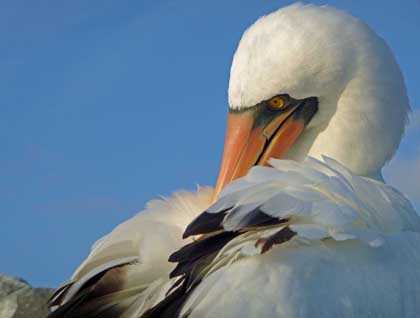Our expedition at Española Island was a spectacular display of a natural symphony of wildlife, and the splendor of the place was experienced from the very first moment we begun the exploration. Gardner Islet was the best way to begin the day as we went for kayaking at 6:30 a.m. The day was sunny and warm and our intrepid explorers were very good. The kayaks followed along the coast and enjoyed several species of sea birds and sea lions that were resting on a very dramatic cliff that forms this place. After this we returned to our ship and enjoyed a nutritious breakfast – we deserved it!
Deep water snorkeling and swimming were the next activities. Once in the water a completely uncommon world was revealed to us: reef fishes of many different colors were swimming around, playful Galapagos sea lions were moving towards us, eagle rays, sea stars and a beautiful sunlight made the experience perfect. At the end of the activity, a big aggregation of black stripped salemas made us feel like we were inside a natural fish tank.
Once back onboard the National Geographic Islander, Gardner Bay Beach was open to us in all of its splendor. As soon as we arrived, the wonders of nature were shown in a big sea lion colony. Sea lions of many different sizes were all over the beach as if they were in a very important meeting. As an additional companion, the hood mockingbird was very curious of our camera lenses. Later, back onboard, we enjoyed a delightful Ecuadorian buffet lunch as we motored to our next destination.
During our afternoon exploration we went to visit a fantastic spot where sea birds and colorful iguanas were found everywhere. This place is known as Punta Suarez; one of the most famous visitor sites of the Galapagos. Sally light-foot crabs were painting the rocks into a red color. Farther inland, blue footed and nazca boobies played a melody of sounds as they were nesting on the rocks. Swallow tailed gulls made a perfect combination of natural colors by populating the entire cliff area. However, the main attraction was definitely the few waved albatrosses we found. Now is the time when they come back to reproduce on this island every year. They migrate from January to March all the way down to Peru and Chile, and this is the only island in the world that they use to live and to ensure the survival of their species. Another highlight is the “blow hole” a geological formation at the foot of a very impressive cliff from where Albatrosses jump off every time they need to take off and glide around the archipelago in search of food. Today was spectacular! On the way back, a Galapagos snake surprised us while moving in between the rocks.
At the end of the adventure, we enjoyed a splendid landscape while watching one of the most beautiful sunsets that Mother Nature could offer to us. Española Island was definitely marvelous to experience on our second day in the Galapagos Islands.







